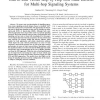Free Online Productivity Tools
i2Speak
i2Symbol
i2OCR
iTex2Img
iWeb2Print
iWeb2Shot
i2Type
iPdf2Split
iPdf2Merge
i2Bopomofo
i2Arabic
i2Style
i2Image
i2PDF
iLatex2Rtf
Sci2ools
ICNP
2009
IEEE
2009
IEEE
End-to-End Versus Hop-by-Hop Soft State Refresh for Multi-hop Signaling Systems
Abstract--To ensure state synchronization of signalling operations, many signaling protocol designs choose to establish "soft" state that expires if it is not refreshed. The approaches of refreshing state in multi-hop signaling system can be classified as either end-to-end (E2E) or hop-by-hop (HbH). Although both state refresh approaches have been widely used in practical signaling protocols, the design tradeoffs between state synchronization and signaling cost have not yet been fully investigated. In this paper, we investigate this issue from the perspectives of state refresh and state removal. We propose simple but effective Markov chain models for both approaches and obtain closed-form solutions which depict the state refresh performance in terms of state consistency and refresh message rate, as well as the state removal performance in terms of state removal delay. Simulations verify the analytical models. It is observed that the HbH approach yields much better state synch...
| Added | 19 Feb 2011 |
| Updated | 19 Feb 2011 |
| Type | Journal |
| Year | 2009 |
| Where | ICNP |
| Authors | Xiaoming Fu, Jianhua He |
Comments (0)

